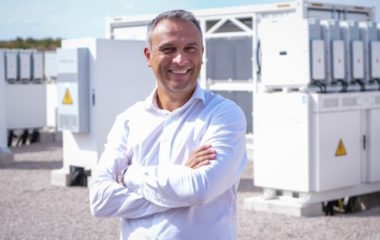
Photo: Dejan Stojčevski
The COVID-19 pandemic has rocked electricity markets across Europe, including Serbia. “Prices on SEEPEX in May dropped by about 40% against the three-year average. This trend will continue for some time, while forecasts beyond that period will depend on how fast consumption returns to pre-pandemic levels,” according to Dejan Stojčevski, Chief Operating Officer of the SEEPEX power exchange. In an interview with Balkan Green Energy News, Stojčevski also talked about how the market can help speed up the development of renewable energy capacities, how the balancing of electricity production from these intermittent sources works, and how fossil fuel plants are losing the race to green power plants.
In the last three years, prices of electricity in May on Serbian power exchange SEEPEX averaged at about EUR 41 per MWh, while this past May the price was about EUR 24 per MWh, a 40% drop. Based on the price of futures for Q3 this year, the currently projected electricity price for the July-September period is EUR 42 per MWh, which would be a similar year-on-year plunge.
“There has been a decline in production, which has lowered prices throughout Europe, with prices in Western Europe hovering between EUR 20 and EUR 30 per MWh. This trend will continue for some time, while forecasts beyond that period will depend on whether industry and the services sector will recover to pre-pandemic levels,” says Stojčevski.
On May 24, the price on this market hit an all-time low, of just EUR 6 per MWh, while the price in Western Europe was even negative. Low prices forced the owners of coal- and gas-fired power plants to curb production or launch overhauls ahead of time.
Low prices forced the owners of coal- and gas-fired power plants to curb production
“It simply doesn’t pay off for them to operate. It’s better to buy electricity on the market. On the other hand, power plants using renewable sources operated without problems,” says Stojčevski, who was one of the participants in a regional workshop held under the REPCONS project.
It seems as if this signal from the market, which is nothing new, even in these extraordinary circumstances, underscores the inevitable – fossil fuel power plants are losing the race to green power plants.
The market could play an important role in speeding up the development of renewable energy sources
Stojčevski says that the market, both bilateral and organized (exchanges), could play an important role in speeding up the development of renewable energy sources in the region as well.
The market has an important role especially when investments do not depend solely on incentives guaranteed by the state.
“For renewable energy producers to independently participate on the electricity market with a profit, they need a market environment with all the products that go with it. Access to cross-border capacities, financial markets, bilateral markets, day-ahead and intraday organized markets (exchanges), imbalance markets, a 15-minute imbalance settlement period, and transparency are the necessary requirements for the development of renewable energy sources and greater investments in this region,” according to Stojčevski.
The three main challenges to a greater influence of the market on renewables are the imbalance settlement price, balancing costs, and the imbalance settlement period
Currently, the region has bilateral markets (long-term, day-ahead, and intraday) and organized markets – exchanges (futures and day-ahead). The only type of market that is missing is an intraday organized market, or, more precisely, an intraday product on SEEPEX, which is the only power exchange in the region outside the European Union (EU). This product is expected to be implemented during 2021.
In Stojčevski’s view, the three main challenges to a greater influence of the market on renewables are setting the imbalance settlement price, balancing costs, and the imbalance settlement period.
Many engineers and economists, not just the wider public, know very little about balancing
Balancing has been considered a mystery in the past years. This is largely due to the lack of knowledge about it, says Stojčevski, adding that many engineers and economists working in this field, not just the wider public, know very little about it.
What exactly is the balancing of renewable energy sources? It is covering the difference between the declared production plan and the achieved output. A balance responsible party can comprise one or more renewable energy producers and it is obliged to send its production plan a day ahead and can change it one hour at the latest before it starts realizing the plan.
Technically speaking, balancing, i.e. covering the difference between the planned and the achieved output, can only be performed by a transmission system operator (TSO), and in order to do that it must buy electricity on the market. Based on the price it pays for electricity and special formulas defined under market rules, the TSO calculates the imbalance settlement price. This price, for one-hour intervals, is posted daily by the TSO on its website.
The balancing cost depends on the imbalance settlement price and the size of the renewable energy producer’s deviation from the production plan
The difference between the planned and the achieved output multiplied by the imbalance settlement price is the balancing cost, and that cost is then distributed among the balance responsible parties. That cost, according to Stojčevski, depends on the imbalance settlement price and the size of the renewable energy producer’s deviation from the production plan.
Crucial for renewables development is who pays balancing costs
The problem, according to him, is not how to balance intermittent renewable energy sources, but the cost of it.
The key question for investors today, and for the development of renewable energy sources in the region, is who will pay for the balancing cost.
And this is the key question for investors today and for the development of renewable energy sources in the region.
Who will pay for that cost? The answer to this is also the answer to the question of what will be the future model for the development of renewable energy sources – what model will replace the feed-in tariff.
Investors, or producers, may be told to pay for the balancing cost by themselves, which means that one or more power plants would make one balance responsible party, or to pay someone to perform the role of the balance responsible party. Another model would be for the balancing cost to be paid by consumers to through their electricity bills.
Investors are not yet ready to bear the cost of balancing
In the current situation, according to Stojčevski, investors are not ready to bear the cost of balancing, because it is only under such circumstances that they can build a wind farm or a solar power plant today.
The market can help reduce balancing costs
What is the role of the market there? It can help reduce balancing costs, primarily the portion that relates to the difference between the planned and the achieved production. The better the planning the lower the cost.
If, for example, a producer is responsible for balancing, it can buy or sell electricity on the market to cover the difference between the plan and the realization and thus reduce the cost.
In order for balance responsible parties to plan better and position themselves, they need intraday markets on exchanges
“The idea behind the balancing system is to make balance responsible parties, or producers, to plan and position themselves as best as they can, because balancing energy is the most expensive energy. However, for balance responsible parties to do so, they need a market, primarily intraday markets within power exchanges,” says Stojčevski.
The imbalance settlement period should be reduced from the current 60 minutes to 15 minutes
The difference between the planned and the achieved production can be reduced through better planning as well, but this is hard to do, especially for wind turbines. That is why they would benefit from reducing the imbalance settlement period from the current 60 minutes to 15 minutes. Currently, wind farms submit one-hour plans, while variations occur in much smaller intervals.
“The ideal period for them would be 15 minutes, as is the case in the EU, because the shorter the period the smaller the error. In order to reduce the imbalance settlement period, it is necessary to change certain regulations and invest in infrastructure,” explains Stojčevski.
How do guarantees of origin work?
A guarantee of origin is an electronic document verifying that energy is produced from renewable sources, and they are issued to a producer by an independent national institution since they work at the national level only.
The idea to introduce guarantees of origin came from the north of Europe, from Sweden and Norway, where the market is the most developed. The objective is to raise awareness of the importance of green energy and reduce harmful emissions.
If everyone decided to buy only electricity with renewable energy guarantees of origin, then there would no longer be a need for fossil fuels
“Hypothetically speaking, if everyone decided to buy only electricity with renewable energy guarantees of origin, then there would no longer be a need for generation capacities that emit harmful gases, or investments in such capacities,” says Stojčevski.
Guarantees of origin can be traded as well, and their end buyers are energy consumers, such as cement plants, who wish to demonstrate that they are using green energy.
“For energy producers, this represents additional revenue. It is not substantial, since the price of a guarantee of origin is between EUR 0.2 and EUR 0.5 per MWh, but it can help lower the costs of balancing,” says Stojčevski.









Be the first one to comment on this article.